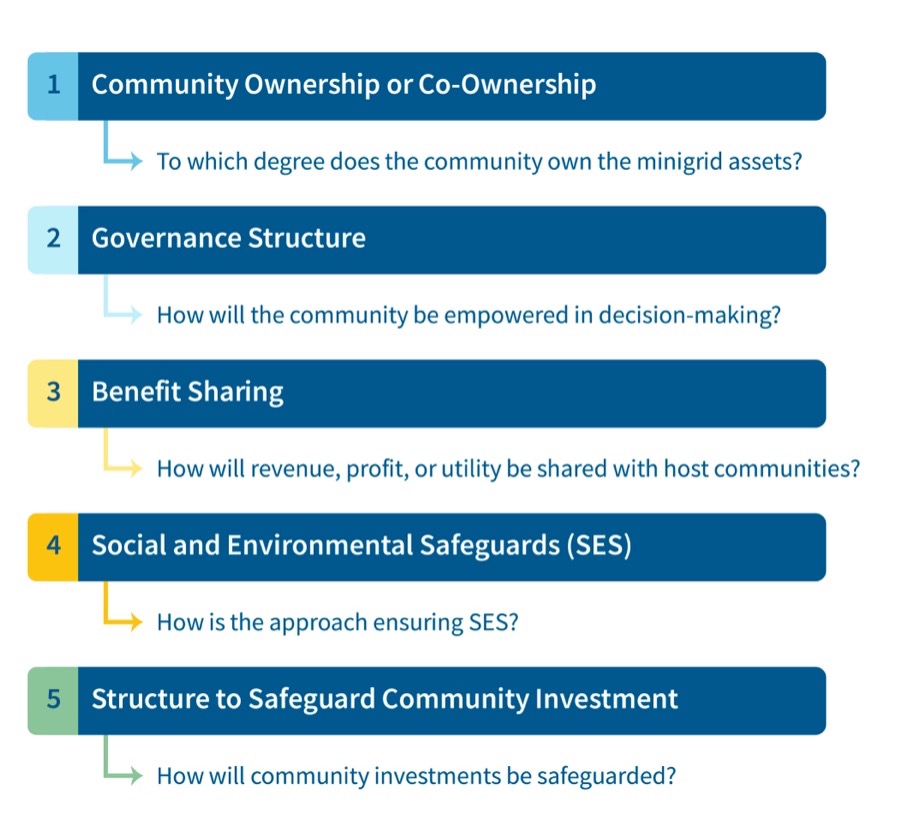
Empowering Energy Access with a Community-Centric Approach
The Community-Centric Minigrid Toolkit provides a practical guide and insights into designing and implementing community-centric minigrids in Africa.
Across sub-Saharan Africa, rural communities continue to face severe barriers to reliable and affordable electricity. Minigrids are widely recognized as a way of overcoming these barriers and as a cornerstone of universal energy access. Yet, the development and deployment of minigrids are not without challenges, particularly when it comes to long-term sustainability and truly serving community needs.
Many minigrids today are delivered through top-down models, led by either public agencies or private developers, and with limited community involvement during project design and execution. These projects can result in low system utilization, insufficient ongoing community buy-in, and ultimately viability challenges. On the other end of the spectrum, fully community-led models such as the cooperative model enable stronger local decision-making, but often place responsibilities of minigrid ownership, operation, and maintenance on communities, who tend to lack capacity to manage them sustainably.
There is a clear need to strengthen existing minigrid delivery models by embedding more meaningful community roles into the minigrid life cycle. Doing so requires interventions to better account for a community’s intrinsic needs and dynamics, while improving development impacts and empowering communities to drive their own energy future. Recognizing this need, the Africa Minigrids Program (AMP) has developed the Community-Centric Minigrid Toolkit, a new resource to provide guidance and share early insights on designing and implementing community-centric minigrids.
The community-centric approach: an adaptable complement
Rather than introducing a new delivery model, the community-centric approach offers a set of adaptable design principles that can be applied across different minigrid delivery models. At its core, this approach aims to rebalance roles and responsibilities among public institutions, private developers, and communities to improve project outcomes and enhance local ownership and accountability.
The approach is built on five key aspects with the overarching goal to better serve community needs, priorities, and context. They are not prescriptive and highly flexible. Minigrid practitioners can adopt and tailor them in part or in full, based on community relationship, feasibility, and project goals.
The toolkit shares practical guides and lessons from the field
The Community-Centric Minigrid Toolkit offers a practical framework and actionable guidance to help developers, policymakers, and implementing partners apply community-centric principles across the minigrid life cycle, from pre-feasibility and stakeholder consultation to operations and monitoring, evaluation, and learning. It draws on hands-on experiences and case studies from multiple African countries, including Burkina Faso, Botswana, Ethiopia, and pilots under the Sharing the Power initiative in Nigeria.
Early pilots and field experiences with the community-centric approach reveal both its potential and its complexity. One of the clearest takeaways is that one size does not fit all. While the design principles are consistent, implementation must adapt to each community’s social, financial, and institutional contexts.
In Mbiabet (Akwa Ibom State, Nigeria), for example, the community holds a 20% equity stake in the minigrid, with a formal Community Reinvestment Sub-Committee managing profits, leveraging existing leadership structure. Meanwhile in Chikaji Hausa and Chikaji Gwari (Kaduna State, Nigeria), the developer allocated a share of revenues to community projects without formal co-ownership, guided by an expanded community governance committee to ensure accountability.
Strong partnerships are key. Developers should not be expected to carry the full burden of community engagement and capacity building. In Mokoloki (Nige State, Nigeria), it took the coordinated effort of the developer, Rural Electrification Agency representative, and project partner to restore trust after service disruptions and tariff tensions. A Joint Operating Agreement and increased financial transparency helped re-engage the community. This also underscores that public sector actors and development partners have a critical role to play in supporting implementation, bridging the capacity and financing gaps through technical assistance, facilitation, and concessional and flexible funding.
Financial viability remains a complex and evolving challenge. Early insights show a promising trend that involving community into financial decision-making could translate into improved perceptions of fairness and satisfaction with electricity tariffs, even if those tariffs remain unchanged. As these projects will often only be as successful as the number of residents willing to pay, this buy-in is crucial. Finally, inclusion matters. In Jamataka (Botswana), the women and youth apprenticeship program led to stronger community ownership and broader development outcomes.
Together, these examples highlight the adaptability of the community-centric approach and its potential to elevating communities from passive recipients to active partners for more sustainable, inclusive rural electrification.
Toward more inclusive and scalable rural electrification
Enhancing community engagement and empowerment aren’t just good practices, they’re a powerful lever for building energy access solutions that are more resilient, equitable, and ultimately more sustainable. More importantly, to enable energy access to unlock economic and social development. The path to inclusive, financially viable minigrids is still unfolding, and many key questions remain underexplored. The Community-Centric Minigrid Toolkit aims to serve as a starting point, and we invite developers, governments, financiers, and communities to experiment, adapt, and share lessons as they apply these principles in practice, and together refine and shape future minigrid deployment. We encourage partners and interested practitioners to join AMP’s Community of Practice to discuss and share insights on the topic further including the upcoming webinar on December 4 on this topic.
Download the Toolkit here and learn how you can deepen local impacts and improve project outcomes with the community-centric approach in your next project.
Learn more in this video: Empowering Africa’s Future with Community-Centric Minigrids
The author wishes to thank Sascha Flesch, Christelle Odongo, and Caroline Tresise for their contributions to this article.

